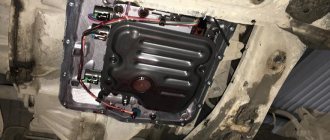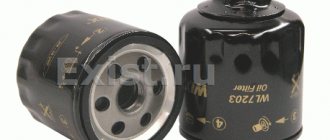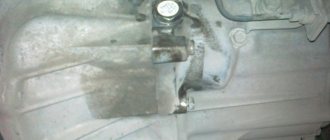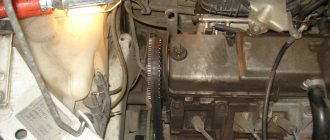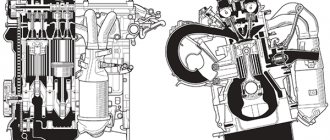Changing the oil will help the Toyota Camry automatic transmission last up to 250 tkm without repairs. A master will charge 12,000 - 18,000 rubles for working with materials, but the service is not always available nearby. In order to change the transmission lubricant yourself and not break the box, you need to understand the structure of the machine, purchase consumables and follow the instructions. Toyota Camry V50 series was equipped with Aisin U241, U660 and U760. Let's look at how to replace ATF with your own hands using the example of the most popular and modern 6-speed U660/U760.
When to replace
Changing the engine oil is an important event in the life of every vehicle. Motor oil performs several important tasks, including:
- Protection of the engine from overheating, as well as its components from accelerated wear.
- Prevention of corrosion.
- Removing from working areas such engine work products as metal shavings, soot, carbon deposits, etc.
Depending on the type of oil, it may contain various additives. They promote self-cleaning of the engine while controlling oil viscosity.
Many motorists are interested in when the oil in a Toyota Camry engine should be changed. This working fluid oxidizes over time and, accordingly, loses its positive properties. Each driver can find the frequency of oil changes in the technical manual for their car. It is worth noting that this figure varies for European and CIS countries, so be sure to find the relevant data in the documentation for the car.
If for some reason you were unable to find this information, then it would be optimal to change the oil on Toyota Camry v40 and v50 every 10 thousand kilometers. You can reach 15 thousand, but this is a last resort. It should be borne in mind that this indicator is also influenced by several parameters such as:
- Features of car operation (aggressive or calm driving style, frequent stay in traffic jams).
- The quality of the fuel used.
- Age of the vehicle.
- Climatic conditions (in hot weather the oil life is reduced).
In some cases you will need to replace more frequently. Oil wear can also be determined visually. It is necessary to warm up the car to operating temperature, and then take a small amount of oil with a pipette, and then drop it onto regular or filter paper. When it is absorbed, you will see a small spot that consists of an outer and inner circle. If the outer circle is sufficiently blurred and has a light tint, then the oil is in good condition. If the outline of the outer circle is clearly visible and the color of the mark is close to the color of burning, it is recommended to replace it.
How to identify original Toyota oil by the appearance of the packaging?
In the CIS countries, car owners are more concerned about the authenticity of Toyota oil. Because often a fake is passed off as an original.
We will briefly tell you how to distinguish original Toyota oil from counterfeit ones by external signs.
Plastic canister
To distinguish the original from a fake by the appearance of a plastic 5-liter canister, study the following.
- Lid. The real lid differs in color (the fake one is much lighter) and stamping, which is clearly visible in the photo.
- Plastic color. The original packaging is light gray glossy. The fake one is darker and doesn’t shimmer as much.
- Marking on the bottom. On a real canister, all the symbols are clear and easy to read. The non-original is blurry and blurry.
- Stickers on the canister. On the back side there is a multi-part sticker, the top layer peels off easily, you can easily read what is written inside. The top layer of a fake peels off poorly, can tear, and does not stick back well.
Metal containers
There is a stereotype that lubricant in metal containers is counterfeited less often due to the fact that a tin canister is more expensive to manufacture. Maybe this was once the case, but now you can buy fake oil in metal.
We list a few differences between the original in a tin container and the fake:
- Metal color and texture.
- Pen. In the original it is fastened neatly, in the fake it is noticeable negligence.
- Weld seam. For a real canister it is processed perfectly, but for a fake it is a completely different matter.
What oil to use
When choosing a lubricant, you need to focus on the type of engine and year of production of the Toyota Camry, since the Toyota WS line of oils is represented by several types of products. For a new car model, it is necessary to use a lubricant that thickens less in cold weather and also retains its properties even at extremely high temperatures, reaching 130°C. The product code is printed on the packaging. Liter cans are marked with code 08886-80807, 4-liter canisters have code 08886-02305, and 20-liter barrels have code 08886-80803.
In addition to the fluid itself, to replace it you will need to purchase some consumables, namely:
- Automatic transmission pan gasket with catalog number 35168-73010 (cost about 550 rubles);
- O-rings with article number 90301-27015 (costs approximately 150 rubles);
- Oil filter for automatic transmission with catalog number 35330-73010 (price tag varies between 2000-2500 rubles).
Spare parts
The best choice for new internal combustion engines on Camry v50, v55 is Toyota SN 0w-20 (code 08880-83265), 0w-30 (code 08880-80365) or 5w-30 (08880-80845).
You can fill in oils 5W-30, 10W-30, 15W-40 and 20w-50 (the choice of viscosity depends on the climate in which the machine is operated). Some Camry owners prefer products from other brands: Shell, Mobil, Liqui Moly, Addinol, Valvoline, Castrol, Motul, etc.
The oil filter is a plastic reusable housing, inside of which a replaceable insert with rubber seals is inserted. The original cartridge is marked 04152-YZZA1. Often its catalog number is indicated on the packaging or in price lists (04152-31090). Know that these are the same part.
Analogues are produced by MANN, Alco, Fram, Kitto, Knecht (Mahle), Nipparts, SCT, Filtron, Bosch and other companies.
When is it necessary to change the automatic transmission oil?
The frequency of oil changes in a Toyota Camry automatic transmission raises many questions among its owners, but it is almost impossible to give an unambiguous answer to this question. This type of work should be performed at 80-100 thousand kilometers, but sometimes it is necessary to replace it even earlier.
Changing the oil in automatic transmission Honda Accord 8
An important indicator is the oil level in the transmission. Various problems often occur, due to which on a Toyota Camry the automatic transmission oil needs to be changed or topped up earlier. This applies to both the 2014 model and the others. For example, such a need often arises due to loosening of the support bolts of various automatic transmission elements, damage to the sealant, wear of individual automatic transmission elements, or the appearance of play in the input shaft.
In such cases, changing the oil in the automatic transmission of a Camry 40 body can only partially solve the problem, since if there is no repair, the problem will recur very soon. If you encounter a similar problem, we recommend that you contact real professionals for diagnosis and repair, who will find and fix the problem as soon as possible.
In addition, the oil change in the automatic transmission of a Camry 50 body must be completely carried out even if it loses its technical characteristics. The main parameter for assessing the quality of oil is its color. Ideally, automatic transmission oil has a red color with various shades, but due to the appearance of rust and foreign impurities from the transmission, it can change color even to brown.
A change in oil color is a direct indicator and proof of the appearance of foreign impurities, which significantly reduces its performance. Due to the presence of microscopic additives that are not characteristic of oil, the latter does not have a sufficient lubricating and heat-removing effect, which can lead to serious problems. Moreover, increased pressure in the system “sends” microparticles at high speed to vulnerable elements of the system, which leads to their thinning and rapid degradation.
If you are not sure about the quality or quantity of automatic transmission oil, then use the appropriate dipstick. On it you will always find maximum and minimum marks that will allow you to accurately assess the current oil level. In turn, you can determine the color of the oil by applying a drop of material from the dipstick onto a white paper napkin, cloth or paper.
So, if you have determined that you need to change the oil in the Camry automatic transmission, we recommend that you begin the appropriate work as soon as possible. By the way, if you are the owner of the long-popular Grace model, then the article does not bypass you.
How to change it yourself?
A Toyota Camry oil change is required approximately once every 10 thousand kilometers. These are the optimal times, during which a lot of dirt does not have time to accumulate, while the liquid accumulates enough to be used up. If you use a branded one, you can postpone the replacement for several thousand km; if it’s Lukoil, it’s better not to deviate too much.
If necessary, you can change the engine oil in your own garage. To do this, you need to be well prepared, have the necessary tools, filters and gaskets, as well as a container for waste fluid.
Changing the engine oil is carried out according to the following scheme:
- the car is placed over a pit or driven onto an overpass. The engine needs to be pre-warmed;
- After this, you need to remove the crankcase protection element, unscrew the drain plug, the oil will drain into a placed bucket. This will take about a quarter of an hour;
- then you need to replace the filter, tighten the drain plug and put it back;
- the new one is filled through the cap located on the engine, it is under the hood;
- check the fluid level, start the car, wait about a minute until the engine shows that it is working correctly, and turn it off again;
- At the very end we check the oil again. We do this after the engine has cooled down; if the level is insufficient, you need to top it up. If there is a lot of fluid, you can leave it as is, the car itself will squeeze out the excess.
Action scenario
It is necessary to warm up the engine to operating temperature. If the replacement option with flushing the power unit is used, then a special liquid from Toyota is poured into its depths 15 minutes after the shutdown in a volume of no more than half a liter. Then you should let the engine run for about another half hour.
The drain plug is unscrewed through the hole in the crankcase protection. Next, place a container designed to hold at least five liters of oil, since its volume in the engine is 4.3 liters. To drain the maximum amount, wait at least 20 minutes, since drops of waste are removed from the crankcase by gravity for a long time.
The flushing agent is not required to be used at every oil change. It is relevant when switching to its new modification.
The oil filter must be replaced together with the oil. For dismantling, it is advisable to use a puller.
The filter seat must be cleaned, its rubber seal must be lubricated, and the housing must be filled 2/3 of the volume with fresh oil.
Next, you should screw the plug on the crankcase and, making sure that the car is on a horizontally level area, pour 4.4 liters of new oil into the neck.
After starting the engine, the oil level will drop by about 100 grams, which will be the normal level on the dipstick.
The level should be re-checked after a test drive.
How often does it need to be replaced?
During operation of the transmission of any car, especially if it is new, grinding of parts occurs, as a result of which a certain amount of chips gets into the oil. As it is produced, the fluid becomes more viscous and darker, and begins to interfere with the operation of the gears. That is why you should strictly observe the frequency of maintenance and update the oil on time. And therefore it is difficult to answer the question of how much oil is needed.
You can find out the exact number by looking at the service book, however, if the car is not new, the book may be lost. Different experts recommend different periods of consumable fluids - from 40 to 110 thousand km. The more often the oil is changed, the better, but for optimal operation of the gearbox you need to intervene no more than 70 thousand km. This principle is considered the most suitable, since it requires less financial costs, and the oil is not changed at the most critical moment, having time to remove contaminants without becoming unsuitable for further use.
Reviews
Vitaly, Moscow region. I have driven 88 thousand km on a 2011 Camry, I am the first owner. I like the stylish design, almost like Lexus cars. The presentable exterior evokes a resemblance to premium sedans, which is only a plus for my old lady. The car steers predictably and “digests” all road irregularities. It would seem that everything suits me - alas, with the exception of the slow automatic transmission, which seems to have been borrowed from another car. There are no complaints about the 2.5 engine yet.
Mikhail, Rostov region. I have a 2021 Camry, version with a 2.5 liter engine and automatic transmission. The good old atmospheric engine was borrowed from its predecessor - more alive than all living things, as they say. But it feels like it works much quieter. The car consumes around 12 liters in the city and up to 9-10 liters on the highway.
When is it time to change your engine oil?
The frequency of changing engine oil in a Toyota Camry should not exceed 7 thousand kilometers in domestic operating conditions, which have proven to be very difficult.
This is characterized by:
- climatic features;
- poor fuel quality;
- unprofessional service.
Therefore, the factory instructions recommend changing the oil after 14 thousand km. for the Russian market is adjusted by half - to the level of seven thousand.
If this recommendation is followed, the choice of oil manufacturer can be treated less carefully: fill in synthetic products from Mobil or Shell, which some ordinary people consider to be not inferior to the branded one from Toyota.
If you have to deal with a counterfeit version from two of these brands, then the reduced replacement interval can give you hope that the motor will not be damaged. If, nevertheless, operating conditions predispose to changing the oil at intervals of 10 to 15 thousand, then there is only one option - filling with the original product.
The process of changing the oil is not particularly difficult and provides the opportunity to do it yourself. If you perform this procedure for the first time, you may encounter some minor problems.
What happens if you don’t change the oil in a timely manner?
Driving on used oil carries with it several dangers, in particular:
- Possible engine overheating. Old oil dissipates heat much worse.
- Increased friction between moving engine components, resulting in accelerated wear.
- Reduced anti-corrosion protection.
- Accumulation of fuel combustion products inside the engine, which eventually clog the oil channels.
All this, at best, will lead to increased fuel consumption, and at worst, to a major engine overhaul.
Box operating modes
The automatic transmission model and control method (hydraulics, electronics) determine the set of its operating modes. Regardless of the type of transmission on the Camry, there are several main modes:
P – parking mode. It should be chosen when parking for a long time. The gearbox is turned off, the shaft is blocked, and the drive wheels do not rotate.
R – reverse gear. You can transfer to it from “parking” and “neutral” only after stopping the car. N – neutral mode. The box does not transmit torque to the wheels, but the shaft is not blocked and the drive axles can rotate
In this mode, the car can be towed over a short (important!) distance. 2 – movement is blocked in gears above 2. This gearbox mode is suitable for bad roads, frequent ascents and descents, since it uses engine braking. L – low gear
It is recommended to use it on steep slopes and off-road; in it, Toyota moves only in 1 transmission stage. D – main mode of the box, forward movement.
There may also be additional buttons on the lever - Overdrive (O/D), SNOW, PWR, MANU, NORM.
- NORM/PWR – switches transmission modes from normal to sports. In the second, the gear shift logic changes, the car becomes more dynamic, but consumes more fuel.
- SNOW – “winter” mode, in which the car starts from 2nd gear, making it easier to start driving on ice and snow.
- MANU button – found mainly on Toyota, similar to Snow.
- Overdrive – permission to use overdrive. When overdrive is active, the car is allowed to switch to the last gear (5, 6...); when overdrive is disabled, it is not. Many people recommend turning off overdrive in the city cycle to increase the service life of the box.
One of the options for the Overdrive button:
Scheme of operation of a classic automatic transmission:
Appearance of the gearbox shift lever on a Camry in the V50 body:
As you can see, there are “+” and “-” symbols: this means that the box can operate in “manual” mode, when the driver himself tells the box when to downshift or upshift. This mode is close to the operation of classical mechanics.
2.6. Changing engine oil and filter
| GENERAL INFORMATION |
| EXECUTION ORDER |
| 1. Position the vehicle so that the drain plug is at its lowest point. |
| 2. Loosen the drain plug approximately half a turn, place a container for drained oil under the drain plug, then unscrew the plug completely. |
| 3. Allow the used motor oil to drain for a while. As the oil drains, gradually move the container towards the stream of oil. |
| 4. Clean the drain plug with a clean cloth. Remove the old O-ring from the plug and install a new one. Clean the location where the plug is installed on the pallet. Screw in the drain plug, tightening it to a torque of 25 Nm (for diesel engines 35 Nm). |
| 5. To replace the filter, place a container under the oil filter. |
| 6. Using a special oil filter wrench, unscrew the used filter. |
| 7. Clean the connection surface, lubricate the rubber gasket with fresh oil and screw in a new filter. |
| 8. Screw in the oil filter by hand until the rubber gasket touches the engine, then tighten the filter by hand 3/4 of a turn (according to the installation instructions included with the filter). |
| 9. Fill with fresh oil through the oil filler neck located in the cylinder head cover, maintaining the correct level. |
| 10. Start the engine and let it run for a few minutes, then check for leaks around the oil filter and the oil pan drain plug. Warning After starting the engine, the oil pressure warning light will remain on for some time until the pump pumps fresh oil into the line. |
| 11. Turn off the engine and wait a few minutes for the engine oil to drain into the pan, then re-measure the oil level and add oil if necessary. Warning If metal shavings are present in the used engine oil, this usually indicates wear on the crankshaft main or connecting rod bearings. |
| 12. The volume of engine oil corresponding to the difference between the “MAX” and “MIN” marks on the oil level indicator is approximately 0.5–1.0 liters. |
| Warning It is strictly forbidden to pour oil above the “MAX” mark. Overfilling the oil leads to failure of the crankshaft seals and catalyst. When changing oil, it is advisable to use motor oil of the same type and brand. It is advisable not to mix oils of different brands (when adding or replacing). When changing the type and brand of oil, it is necessary to flush the engine with a special product that is added to the oil before changing it. Oils of the same type and brand, but of different viscosity, can be mixed without restrictions. |
Engine oil volume, dm3
| Engine | With filter replacement | No filter replacement |
| OHC | 3,75 | 3,25 |
| DOHC | 4,5 | 4,0 |
| V6 2.9 | 4,5 | 4,25 |
| V6 2.4 | 4,5 | 3,8 |
| Diesel until September 1993 | 5,6 | 5,0 |
| Diesel after September 1993 | 6,6 | 6,0 |
Toyota Camry XV50 since 2011
2013 model
According to the operating instructions, the lubricant for Toyota Camry engines is original Toyota oil or lubricants from other companies that have the parameters required by the car manufacturer. The class, type and viscosity of the oil are determined by the type of engine.
Power units 6AR-FSE and 2AR-FE
According to the manual, it is necessary to fill in oils with a viscosity index of 0w-20, 5w-20, 5w-30 or 10w-30, corresponding to classes SL or SM with the designation “Energy Conserving” according to the API system. It is acceptable to use universal lubricants certified according to ILSAC and having a viscosity parameter of 15w-40. You can also use motor oils of groups SL, SN or SM according to the API system.
To select the viscosity depending on the temperature outside the car, use diagram 5.
Scheme 5. The influence of air temperature on the selection of motor oil viscosity.
According to scheme 5, at extremely low temperatures it is necessary to fill in lubricants 0w-20, 5w-20, 5w-30. Motor oils with a viscosity parameter of 10w-30 or 15w-40 should be used if the thermometer reading is above -18C, otherwise starting the engine will be difficult.
The volume of engine oil required during replacement is 4.4 liters including the oil filter and 4.0 liters without replacing the oil filter.
Auto engines 2GR-FE
The manufacturer recommends using motor lubricants with a viscosity index of 5w-30 or 10w-30 if they correspond to the following API classes:
- SL or SM with the designation “Energy Conserving” (energy saving);
- SN marked “Resource-Conserving” (resource-saving).
You can also pour lubricants certified by ILSAC and having a viscosity parameter of 15w-40 or use oil groups SL, SM and SN with the recommended viscosity index.
You can select the viscosity parameter according to scheme 6.
Diagram 6. Predicted temperature range until the next engine fluid change.
According to scheme 6, at extremely low temperatures it is necessary to use 5w-30 lubricants, and when the thermometer is above -18C, pour 10w-30 or 15w-40.
The volume of engine fluid required when replacing is 6.1 liters with oil filter replacement and 5.7 liters excluding the oil filter.
Oil change
Toyota states that the transmission oil is conditionally non-replaceable, i.e. filled for the entire “life” of the box. In practice, automatic transmission oil inevitably becomes contaminated with metal fragments formed during operation and loses its properties due to wear and tear over time. In Russian realities, it is advisable to change ATF every 30-40 thousand kilometers, although it is officially recommended to do this after 50 thousand.
You can verify the need for replacement by visually checking its condition. This is usually done using the automatic transmission dipstick (the location of the dipstick is indicated in the car manual).
To check, the car warms up (you can take a short trip or switch all the gearbox modes one by one), place it on an overpass or pit, after which the gearbox is switched to N, and the control hole plug is removed. A little oil should leak out from there, which determines the quality of the fluid: if nothing leaks out, the oil level in the box is low and requires topping up or replacing the whole thing. When checking with a dipstick (if there is one), you need to “drive” the transmission modes and check what level the transmission oil is at.
Next, the method of changing the oil in an automatic transmission of a Toyota Camry v50 will be discussed in detail.
Two types of shifts are possible:
- Full.
- Partial.
It is advisable to do the full one on a special device; the partial one can be done independently.
It is advisable to check the brand of gearbox oil in the car manual. So, for the U760E gearbox, Toyota ATF WS (original) oil is used:
Changing the oil in the automatic transmission of a Toyota Camry 50 version will require about 12-15 liters of fluid completely, and for a partial oil change - 6.5-8 is enough. It is advisable to use the original, or select the liquid that best suits the tolerances for the box.
It is also advisable to purchase:
- new box filter (article 35330-08010);
- pan gasket (article 35168-21020).
You can also change the drain plug gasket (90430-18008) and the box filter gasket (90301-32010).
Prepared set of parts for replacement (filter, gaskets):
Partial replacement
You will need new oil, a set of gaskets and a filter (see above), tools, and a graduated container for working out.
Algorithm of actions for changing the oil in a Toyota Camry automatic transmission:
- The vehicle is driven onto a lift, overpass or pit, the gearbox is switched to N, the engine is turned off;
- the crankcase protection, if present, is removed;
- the drain plug is unscrewed;
- The oil that has leaked from the box is collected in a prepared container.
Next, the fastenings of the box pallet are loosened:
The oil that flows out is also collected in a container. As a result, the pan needs to be removed and the remaining oil drained from it.
Box with pallet removed:
After this, you need to inspect the box filter; if necessary, it should also be replaced. During the process, some more oil will leak out, which needs to be collected in the same container.
The pan is washed from the remains of old oil and waste (chips, etc.). The gasket is inspected, if it is in good condition, it can be left; if the box pallet gasket is worn out, it is replaced.
Washed box pallet:
Further actions:
- a new filter is put in place, the box tray is also installed back. The drain hole is closed with a plug (you can change its gasket), but not screwed in - so that the oil can flow out through the bypass tube (this is necessary to control the level);
- new oil is added.
Since there is no dipstick, the filler neck is not under the hood, but in the area of the front left wheel, under the plastic body kit:
Fill the oil with a special syringe, hand pump, or other available devices.
After oil begins to flow from the bypass tube, stop filling, tighten all the bolts and plugs, “run” the transmission modes again to disperse the oil through the system, and make a control measurement, adding fluid to the box if necessary.
This completes the replacement.
Step-by-step instructions + photo report
In order to independently change the oil in a Toyota Camry automatic transmission, you must follow the following procedure:
We drive the car into a pit or stand to make it convenient to carry out the procedure.
Remove the front protective cover. This is quite easy to do as it is held on by clips and a few screws.
Now we can see and easily reach the automatic transmission of the car (the photo shows the gearbox)
We remove the plastic protection that is located behind the bumper (optional), since without it it will be more convenient for you to work in the future.
Unscrew the plug and drain the oil from the gearbox
Removing the pallet
The photo shows an automatic transmission, the arrow shows the location of the filter.
Removing the gearbox oil filter
This is quite simple to do; unscrew the fastening bolts and the filter itself comes away from the automatic transmission.
Install a new filter in the automatic transmission in reverse order
Remove the old gasket from the pan and replace it with a new one
Before replacing the gasket, be sure to wash away any traces of wear on the box (old oil, chips, etc.) But pay attention to the magnets that are installed on the bottom, they need to be cleaned and put back, as they attract small used parts while the car is running ( shavings), do not allow her to go back to work. Reinstall the pallet. We pour it into the box and focus on the level. After filling, we moved the automatic transmission handle to the parking position, drive, reverse speed, neutral, added more oil as soon as it began to drip from the bottom hole, stopped adding and tightened all the bolts.
Some Camry models do not have a dipstick installed to measure the oil level in the box, so you can check it when filling as follows. There is an extension installed in the pan (pictured above), through which, in the event of liquid overflow, excess oil will pass through the hole
Therefore, the drain plug must be tightened at the very end of the procedure.
How to change oil in Toyota Camry V50
(The photo shows a 2012 car with a 4-cylinder engine) Changing the oil in the Camry V50 engine is a periodic procedure that is best done independently. Moreover, changing the oil and oil filter with your own hands is quite simple.
To change the engine oil in a Toyota Camry V50, you will need: new engine oil, an oil filter, a new gasket for the drain plug, a container for used oil and a funnel, gloves and glasses, an oil filter puller, wrenches, a jack and stops.
The procedure for changing the oil is as follows:
- Gain access to the underbody of the car.
- Unscrew the oil filler cap. You will need a 14mm socket.
- Unscrew the drain plug, preparing a container for the drained oil in advance.
- Drain all oil.
- Screw in the drain plug. First by hand, and then by tightening it with a wrench.
- Unscrew the oil filter cap.
- Screw in the tool to drain the oil from the filter.
- Drain the oil from the filter.
- Unscrew the tool.
- Unscrew the filter using a puller.
- Remove the oil filter.
- Remove the old filter.
- Remove the old O-ring from the oil filter housing.
- Put on a new ring.
- Install the new filter into the housing.
- Place the cover on and remove the old O-ring.
- Install a new ring.
- Screw on the lid.
- Clean the oil filter seat.
- Install the oil filter.
- Tighten the filter using the same puller.
- Fill with new oil.
- Screw on the lid.
- Start the engine and let it run for a while.
- Check for oil leaks.
- Check the oil on the dipstick and add, if necessary, to the optimal level.
Toyota Camry XV40 2006-2011
2008 release
The recommended engine oil for Toyota Camry according to the car manual must meet the following characteristics:
- All-season motor fluids with the designation “Toyota Genuine Motor Oil” or motor oils with similar parameters, having the appropriate markings or approvals on the canister.
- According to API standards, acceptable lubricant classes are SL or SM. Viscosity parameter according to the SAE system 20w-50 or 15w-40 at a temperature above -12.5 C (temperature selected according to scheme 4).
- In accordance with the API classification, types of motor oils are SL or SM, designated “Energy Conserving” (energy-saving) or all-season lubricants according to ILSAC. Viscosity is selected 10w-30 when the thermometer reading is above -18C, or 5w-30 if the air temperature is below +10C (temperature indicators are taken from diagram 4).
Scheme 4. Dependence of the viscosity index of motor oil on the temperature of the region in which the car will be operated.
Refill tanks for Toyota Camry:
- Engine 2AZ-FE:
- 4.3 l with oil filter;
- 4.1 l excluding oil filter.
- Auto engine 2GR-FE:
- 6.1 l with oil filter;
- 5.7 l without oil filter.

